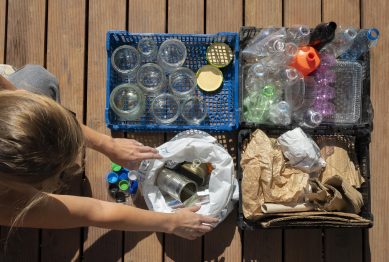How to make your home eco-friendly without breaking the bank is a goal that’s become far more attainable in 2025. With new technology, government incentives, and smarter design strategies, you can significantly reduce your home’s environmental footprint without draining your savings. Eco-friendly living is no longer limited to those with large renovation budgets. Today, you can achieve meaningful changes through a mix of low-cost DIY improvements, strategic investments, and resourceful reuse. This guide explores the most impactful, budget-conscious trends, backed by current research, to help you build a sustainable home while saving Finance.

Start With a Home Energy Audit
Before investing in upgrades, it’s essential to know exactly where your home is losing energy. A home energy audit reveals the problem areas—whether it’s poor insulation, leaky ductwork, or outdated appliances. Professional audits cost around 200 to 700, but homeowners often recoup that investment within the first year through reduced energy bills. For a free alternative, many utility companies now offer virtual energy assessments where you complete a questionnaire and upload photos for expert review. An audit will give you a clear action plan, ranking improvements by potential savings. This ensures you focus on high-impact changes like sealing air leaks or upgrading insulation instead of spending Finance on lower-priority projects.
Weatherization: Simple Steps, Significant Savings
Weatherization is one of the fastest, cheapest ways to improve home efficiency. Even basic steps can result in noticeable savings. Seal air leaks with caulk, foam sealant, and weather-stripping around windows, doors, and plumbing entries. Add insulation in attics, crawl spaces, and walls to retain heat in winter and cool air in summer. Install door sweeps and use draft stoppers to prevent heat loss under doors. Block fireplace drafts with an inflatable chimney balloon or wool draft stopper. A well-sealed home can reduce annual heating costs by up to 15%. Lowering your thermostat by just one degree Celsius can save an additional 5% on energy bills. Over time, these small adjustments stack into hundreds of dollars in savings.
Energy-Efficient Lighting and Appliances
Lighting accounts for about 15% of a household’s electricity usage, so switching to LED bulbs is a quick win. LEDs last up to 25 times longer than incandescent bulbs and use up to 90% less energy. Similarly, upgrading to ENERGY STAR-certified appliances—like refrigerators, washing machines, and dishwashers—can dramatically cut power consumption. While these appliances may cost more upfront, they typically pay for themselves through reduced utility bills within a few years. Smart thermostats are another powerful upgrade. They automatically adjust heating and cooling based on your schedule and the weather, reducing energy waste without sacrificing comfort. Many now integrate with voice assistants, making it easy to change settings hands-free.
Sustainable Refurbishment and Material Reuse
Sustainability isn’t always about buying new—it’s often about making the most of what you already have. This is where sustainable refurbishment comes in. Instead of replacing cabinets, consider repainting or refacing them. Old wood flooring can be sanded, refinished, and even stained in a fresh color for a fraction of the cost of new floors. Using reclaimed materials, such as salvaged wood, recycled glass, or metal, reduces demand for new resources and often costs less. Architectural salvage yards and online marketplaces offer everything from reclaimed bricks to vintage light fixtures, giving your home character while keeping materials out of landfills.
Trending Eco-Friendly Upgrades in 2025
The cost of solar panels has dropped significantly over the last decade, and battery storage is becoming more affordable too. This allows homeowners to store excess solar energy for nighttime use or during peak rate hours. Some households now achieve nearly net-zero electricity bills within seven to ten years of installation. For those unable to make a large upfront investment, solar subscription programs allow you to pay a monthly fee for solar energy without owning the panels, still lowering your utility costs. Automation is a game-changer in energy efficiency. Smart systems can control lighting, appliances, and HVAC units based on occupancy and daylight levels. Motion sensors turn off lights in empty rooms, while smart plugs cut standby power to electronics that aren’t in use. These systems can be integrated into a single app, giving you real-time energy use data and helping you spot waste instantly. In 2025, high-performance insulation materials such as aerogels and hempcrete are more accessible than ever. Aerogels offer exceptional thermal resistance while being lightweight, and hempcrete provides both insulation and breathability. These materials reduce heating and cooling costs while lowering your home’s overall carbon footprint.
Government Incentives and Tax Benefits
Many countries offer rebates, tax credits, and low-interest loans for eco-friendly home improvements. For example, in the U.S., the Energy Efficient Home Improvement Credit allows you to claim up to 30% of qualifying upgrade costs, with a maximum benefit of 3,200 annually. Eligible expenses include energy audits, insulation, heat pumps, and energy-efficient windows and doors. These incentives can substantially reduce the net cost of large projects, making them more financially feasible.
Budget-Friendly DIY Projects
If you’re looking to start small, these projects are low-cost and beginner-friendly. Install a rainwater collection barrel for garden use. Plant shade trees on the south and west sides of your home to reduce cooling needs. Switch to a programmable power strip to cut phantom power from electronics. Use thermal curtains to keep heat in during winter and block sun in summer. Compost kitchen waste to reduce landfill contributions and improve soil quality. Each of these changes can be completed in a weekend and cost under 100.
Summary Checklist: Budget-Friendly Eco Upgrades
Home Energy Audit – Low to moderate cost, identifies high-impact improvements. Air Sealing & Insulation – Low cost, cuts heating and cooling bills immediately. LED Lighting & Smart Thermostats – Low to moderate cost, improves efficiency and comfort. Appliance Upgrades – Moderate cost, long-term savings on electricity. Solar + Battery Storage – High investment, provides energy independence and bill reduction. Recycled Materials Upgrade – Moderate cost, reduces waste and adds unique style. Government Tax Credits – Varies, lowers net project costs.
Practical Tips for Staying on Budget
Upgrade in phases to spread out costs. Focus on high-ROI projects first, such as sealing air leaks before investing in solar. Mix DIY with professional work for maximum savings. Track your progress using utility bill comparisons year over year.
Conclusion
How to make your home eco-friendly without breaking the bank is not just a dream—it’s a practical reality in 2025. From low-cost weatherization to high-impact solar investments, there’s a solution for every budget. By combining small daily habits with smart long-term upgrades, you can create a home that’s comfortable, cost-efficient, and kind to the planet. Eco-friendly living is no longer reserved for major renovations or luxury builds. It’s about making thoughtful, informed choices that fit your budget and lifestyle. Start small, build momentum, and you’ll see the benefits—in your utility bills, your comfort, and your environmental impact.
Reference
- Home Energy Audits — Take Control of Your Energy Usage, https://www.saveonenergy.com
- Lighting Choices to Save You Finance, https://www.energy.gov
- Solar Energy Options on a Budget, https://www.thetimes.com









